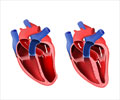A new protein directs an existing heart muscle protein called actin to form a pumping unit in the heart, researchers at the University of Pennsylvania School of Medicine have reported.
They discovered that a protein called leiomodin (Lmod) promotes the assembly of actin protein and guides it to form the pumping unit of the heart.Actin is the most abundant protein found in animal cells and forms long polymers, or filaments, that make up the cell skeleton. In the cells that make up muscles and the heart, interactions of actin filaments with motor proteins produce the contractions that pump blood through the body.
"It appeared that this protein was present in muscle cells but this had not been demonstrated directly and nobody knew what it did," said Roberto Dominguez, lead author and associate Professor of Physiology.
"We compared the amino acid sequence of Lmod with the sequence of another protein called tropomodulin [Tmod] that was already known to bind actin filaments in muscle cells.
We found that one part of Lmod was very similar to Tmod, but Lmod was a bigger protein than Tmod and contained unique features that made us suspect that it could assemble the actin filaments of the heart muscle. This is exactly what we found," he added.
"For a long time, physiologists have wondered what serves as the nucleator protein in cardiac muscle cells," said Professor Thomas Pollard, co-author, PhD, of Yale University.
Advertisement
The team also found that Lmod directed actin filaments to the sarcomere, the part of the heart that controls contractions or pumping. When Lmod was knocked down in cardiac muscle cells by an RNA silencing technique, the sarcomeres became completely disorganized and could not direct muscles to contract.
Advertisement
The findings appear in this week's issue of Science.
Source-ANI
RAS/L











